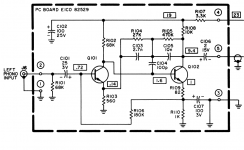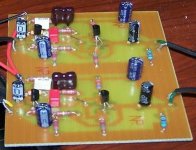Hello,
I would like some information. I needed an RIAA pre amp to convert my LP's to digital, so I built this pre amp. It worked well for my needs. Now I would like to convert this pre amp into a non RIAA pre amp. I'm thinking of using it as an electric guitar pre amp, or general purpose pre amp. I know R104 R105 C103 C104 and C105 set the RIAA curve, what do I need to change to make it into a flat response pre amp?
I would like some information. I needed an RIAA pre amp to convert my LP's to digital, so I built this pre amp. It worked well for my needs. Now I would like to convert this pre amp into a non RIAA pre amp. I'm thinking of using it as an electric guitar pre amp, or general purpose pre amp. I know R104 R105 C103 C104 and C105 set the RIAA curve, what do I need to change to make it into a flat response pre amp?
Attachments
I would dump it and design an op amp guitar pre amp with maybe a presence control.
Adding presence gives the guitar sound bite.
Alternatively if your into rock music look up soft limiters to give a warm valve type sound.
Adding presence gives the guitar sound bite.
Alternatively if your into rock music look up soft limiters to give a warm valve type sound.
I agree with Nigel, there are much more appropriate designs for guitar. In general, guitar sounds best with circuitry that's lower-bandwidth and by most standards "dirty".
If you still want to use it, eliminate c104 and 105/ c104 shouldn't affect the audible range, and may be in their for other reasons than RIAA. If you change the resistors, you have to change other stuff as they affect operating points. Gain will be quite high (1mv in should be close to 1 volt out) YMMV
If you still want to use it, eliminate c104 and 105/ c104 shouldn't affect the audible range, and may be in their for other reasons than RIAA. If you change the resistors, you have to change other stuff as they affect operating points. Gain will be quite high (1mv in should be close to 1 volt out) YMMV
Sorry but no.
1) C103 shorts R104 above 2200Hz, remove it.
2) C105 is in series with R104 and cuts frequencies below 590Hz.
Since this is a negative feedback network, *cutting* here means *boosting* the amp response, so we are boosting low frequencies **a lot**, quite undesirable in a guitar preamp.
Or any other general purpose preamp, except for an RIAA or NAB (Tape head) preamp, so let's raise its value to put it *well* outside the audio range.
Replace it with a 1uF electrolytic, positive towards Q102 collector.
3) Now stage gain is roughly 1+(R104/R103) ~ 50X
Not bad to turn a dynamic microphone signal into a line level one.
Too much gain for any regular electric guitar, it will overdrive easily with a single coil and definitely so with a Humbucker.
Ugly buzzy overdrive, by the way.
Plus input impedance is too low, in the order of 50K.
So it *can* have some use, not much beyond what I suggested.
4) C104 is there to tame HF response, leave it.
5) as suggested above, Op Amps are most versatile design and gain blocks, much simpler to use and with better performance.
Did I mention cheap?😉
Thanks JMFahey and all. I only said guitar because its the only other very low level device I could think of. I could have just as easy said amp for crystal am radio or mic. I have the amp and dont need it anymore so I wanted make some use of it, and not spend anymore money on it.
thanks all.
thanks all.
Attachments
Sorry but no.
1) C103 shorts R104 above 2200Hz, remove it.
2) C105 is in series with R104 and cuts frequencies below 590Hz.
Since this is a negative feedback network, *cutting* here means *boosting* the amp response, so we are boosting low frequencies **a lot**, quite undesirable in a guitar preamp.
Or any other general purpose preamp, except for an RIAA or NAB (Tape head) preamp, so let's raise its value to put it *well* outside the audio range.
Replace it with a 1uF electrolytic, positive towards Q102 collector.
3) Now stage gain is roughly 1+(R104/R103) ~ 50X
Not bad to turn a dynamic microphone signal into a line level one.
Too much gain for any regular electric guitar, it will overdrive easily with a single coil and definitely so with a Humbucker.
Ugly buzzy overdrive, by the way.
Plus input impedance is too low, in the order of 50K.
So it *can* have some use, not much beyond what I suggested.
4) C104 is there to tame HF response, leave it.
5) as suggested above, Op Amps are most versatile design and gain blocks, much simpler to use and with better performance.
Did I mention cheap?😉
Standards RIAA feed back circuit in original circuit. Both caps can be removed for flat response..... However too much gain could be a problem, but 50 would be low for mic , so changing c105 to 1uF will work fine if gain of 50 is ok. 50 = 34 db gain. 500 = 53db gain.
Last edited:
Guitar sound tends to benefit from treble boost to give it bite.
On my effects pedals I always include a presence control.
On my effects pedals I always include a presence control.
Standards RIAA feed back circuit in original circuit. Both caps can be removed for flat response..... However too much gain could be a problem, but 50 would be low for mic , so changing c105 to 1uF will work fine if gain of 50 is ok. 50 = 34 db gain. 500 = 53db gain.
That's the problem with your version.
Mine gives flat response, 50X gain , reasonably flart response, reasonably low distortion and hiss, etc.
A usable preamp.
And 50X gain is fine for a typical dynamic microphone.
Yours, leaves the preamp almost open loop, practically with no NFB, no distortion or response correction, but worst of all, with absolutely unusable 500X gain 😱 , which leaves you with 2 (equally bad) options.
1) you put the volume control in the output (after it), it clips/distorts/farts with the microphone 1 foot away from the singer .... unusable.
2) you put it at the input (so it's *always* full throttle, feeding the following stage): welcome to Niagara Falls.
Oops, sorry, it sounds the same 🙁
- Status
- Not open for further replies.
- Home
- Amplifiers
- Solid State
- Transistor pre amp

